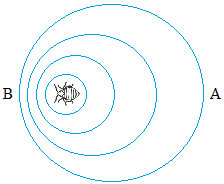What is the Doppler Effect?
What is the Doppler Effect? The Doppler Effect is the change in frequency of a wave for an observer due to the motion of the source.
There are three important things said here.
- Change in frequency
- Motion of the source
- Observer
These 3 things must be in place in the Doppler Effect. Since the change in frequency or Doppler Effect happens when there is motion, let us first discuss the frequency of a wave when the source is not moving.
Situation #1
To create this situation, we may use a bug, a medium (water), and two observers.

If a bug in the water is not moving, but simply bobs at a fixed position, the waves produced will look like the ones you see above. The crests of the wave are concentric circles.
Why do the crests of the wave make concentric circles? It is because the speed of the wave is the same in all direction.
Suppose also that the distance between wave crests is the same. This happens when the bug bobs the water with a constant frequency.
The waves will reach observer A and observer B at the same frequency.
Situation #2
What will happen if the bug is now moving toward observer B? Since the bug is now moving, the circles or crests of the wave will not be formed at the same location anymore. Since the bug is moving toward observer B, the circles will be formed closer and closer to observer B.

For instance, the biggest circle was formed when the bug was at the
center of that circle. By the same token, the smallest circle was formed
when the bug was at the center of the smallest circle. Now, from the
image, you clearly observe the following.
The waves will reach observer B faster than observer A.
Relative to the position of the observer, when the bug is moving, we clearly see a change in the frequency of the waves. And this is what we mean by the Doppler Effect.
What is the Doppler Effect in real life? The sound wave crests from a fire truck

What is the Doppler Effect in the example above? The Doppler Effect is evident when a fire truck is moving toward you.
Because the sound wave crests are more frequent when the fire truck is approaching you, the siren is loud in your ear.
However, as soon as the fire truck has passed, the siren is much lower. This is because the sound wave crests are less frequent as you can see in the illustration above.